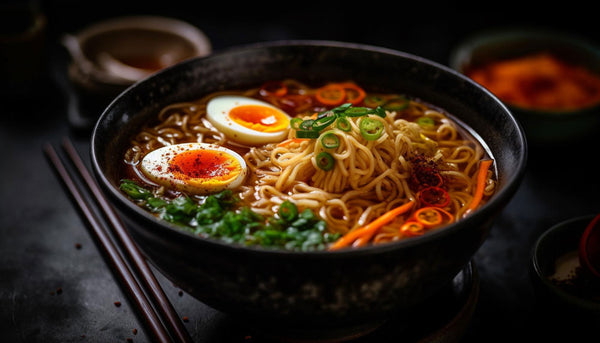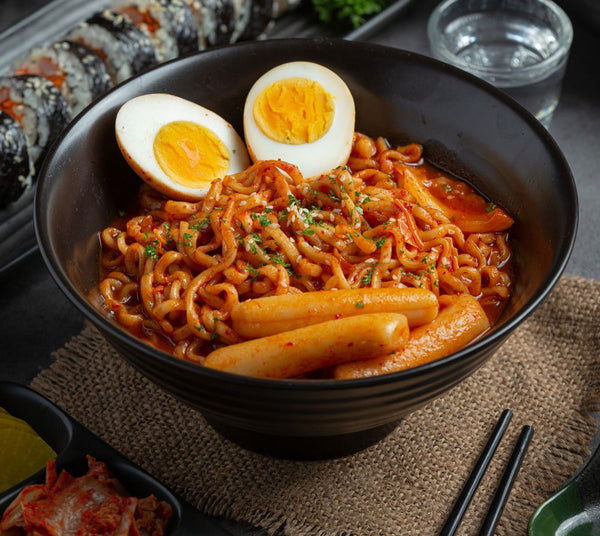Ramen vs Ramyun: Everything You Need to Know About Japanese and Korean Noodles

When it comes to popular noodle dishes, Ramen and Ramyun take center stage in their respective countries, Japan and Korea. These savory bowls have won the hearts of food enthusiasts worldwide, offering a delightful taste of Asian cuisine. Although they may appear similar at first glance, Ramen and Ramyun have distinct characteristics that make them unique to their regions. In this article, we will delve into the fascinating world of Ramen vs Ramyun, exploring their origins, ingredients, preparation methods, and cultural importance.
Ramen: The Japanese Delight

Ramen, a beloved Japanese noodle dish, has captured the taste buds of people around the globe. Its rich history can be traced back to China, where it was introduced before gaining immense popularity in Japan. The dish typically consists of Chinese-style wheat noodles served in a flavorful broth, often seasoned with soy sauce, miso, or pork bone broth.
Origins and History of Ramen
The roots of Ramen can be found in Chinese "lamian" noodles, which were brought to Japan by Chinese immigrants during the late 19th century. Over time, Japanese chefs adapted the recipe to suit local tastes, and Ramen evolved into the iconic dish it is today.
Regional Variations of Ramen
Ramen varies significantly across Japan's regions, each offering its own distinctive flavor profile. Some famous styles include:
- Shoyu Ramen: Featuring a soy sauce-based broth, Shoyu Ramen boasts a balanced, umami-rich taste.
- Miso Ramen: Known for its hearty miso-based broth, Miso Ramen delivers a robust and slightly sweet flavor.
- Tonkotsu Ramen: This creamy and pork-based broth gives Tonkotsu Ramen its creamy texture and indulgent taste.
- Shio Ramen: With a clear and light broth seasoned with salt, Shio Ramen offers a delicate, refreshing flavor.
Ingredients and Toppings
Ramen's ingredients play a crucial role in shaping its taste. The noodles, made from wheat flour, are often thin and chewy, providing a satisfying texture. Various toppings can be added to enhance the dish, such as:
- Chashu: Succulent slices of braised pork belly.
- Menma: Fermented bamboo shoots that add a delightful crunch.
- Nori: Sheets of seaweed that infuse the broth with a sea-like essence.
- Soft-Boiled Egg: Often marinated in soy sauce, the egg adds richness to the broth.

Cultural Significance
Ramen has become more than just a culinary delight; it holds cultural significance in Japan. It is a comfort food enjoyed by people from all walks of life, and its popularity has spawned countless Ramen shops across the country. The act of slurping noodles loudly is also considered a sign of respect to the chef and a way to express enjoyment of the dish.
Ramyun: The Korean Sensation
Ramyun, also known as Ramyeon, is a prominent Korean noodle dish celebrated for its spicy and fiery flavors. This dish has found a special place in Korean hearts, symbolizing warmth, nostalgia, and community.
Origins and History of Ramyun
The origins of Ramyun can be traced back to Japanese-style Ramen, which made its way to Korea during the Japanese occupation in the early 20th century. However, Ramyun has since evolved into a distinctly Korean dish with unique flavors and characteristics.

Regional Variations of Ramyun
Similar to Ramen, Ramyun has regional variations across Korea, with each area adding its own twist to the recipe. Some popular styles include:
- Spicy Shin Ramyun: This variety is known for its fiery broth, filled with chili peppers and spices, providing a satisfying kick.
- Jin Ramyun: With a milder taste, Jin Ramyun offers a comforting and savory experience.
- Seafood Ramyun: Incorporating a medley of seafood flavors, this style is a favorite among seafood enthusiasts.
Ingredients and Toppings
Ramyun typically uses instant noodles made from wheat flour, making it a quick and convenient meal option. The broth is where the magic happens, with spicy chili paste, gochujang, playing a prominent role in creating the characteristic heat. Common toppings include:
- Kimchi: The iconic Korean side dish adds a tangy and spicy element to the broth.
- Boiled Egg: A soft-boiled egg adds a creamy texture to the dish.
- Vegetables: Sliced scallions and carrots bring freshness to the spicy broth.
Cultural Significance
In Korea, Ramyun is not just a meal but an experience shared with friends and family. During colder months or late-night gatherings, enjoying a steaming bowl of Ramyun brings people together, fostering a sense of warmth and connection.
Ramen vs Ramyun: The Key Differences
Now that we've explored the individual aspects of Ramen and Ramyun, let's highlight the key differences between these two beloved noodle dishes:
- Origin: Ramen originated in China and was later adapted and popularized in Japan, while Ramyun has its roots in Japanese-style Ramen but developed into a unique Korean dish.
- Broth: Ramen offers a diverse range of broths, including soy sauce, miso, and pork bone, providing a wide array of flavors. On the other hand, Ramyun is renowned for its spicy and fiery broth, often with a base of gochujang.
- Noodles: While both Ramen and Ramyun use wheat-based noodles, the thickness and texture can vary between the two. Ramen noodles tend to be thinner and chewier, whereas Ramyun noodles are often thicker and have a smoother texture.
- Toppings: The toppings used in Ramen and Ramyun can differ significantly, reflecting the culinary preferences of each country. Ramen is characterized by toppings like chashu and nori, while Ramyun commonly features kimchi and boiled eggs.
- Cultural Significance: Both dishes hold cultural importance in their respective countries. Ramen represents comfort and culinary artistry in Japan, while Ramyun symbolizes community and togetherness in Korea.
FAQs
- Are Ramen and Ramyun gluten-free?
Generally, Ramen and Ramyun are not gluten-free as they both use wheat-based noodles. However, some brands may offer gluten-free alternatives.
- Can I make Ramen or Ramyun at home?
Yes, you can! There are many recipes available online for homemade Ramen and Ramyun. It's a fun and rewarding experience to create these delicious dishes in the comfort of your own kitchen.
- Is Ramen spicier than Ramyun?
Generally, Ramyun is spicier than Ramen. Ramen broths vary in their spice levels, with some being mild and others moderately spicy. On the other hand, Ramyun is renowned for its fiery and spicy broth, thanks to the use of gochujang and other chili-based seasonings. If you have a preference for spicy food, Ramyun might be the perfect choice for you.
- Are there vegetarian or vegan options for Ramen and Ramyun?
Yes, there are vegetarian and vegan options available for both Ramen and Ramyun. Many restaurants and instant noodle brands now offer plant-based broths and toppings, making these delightful dishes accessible to those with dietary restrictions.
- What are some popular Ramen and Ramyun toppings?
Ramen toppings commonly include chashu (braised pork belly), menma (fermented bamboo shoots), nori (seaweed), and soft-boiled eggs. For Ramyun, popular toppings include kimchi, boiled eggs, sliced scallions, and various vegetables.
- Can you share a secret ingredient to enhance the flavor of Ramen or Ramyun?
Sure! One secret ingredient to elevate the flavor of both Ramen and Ramyun is sesame oil. Just a drizzle of toasted sesame oil can add a rich, nutty undertone to the broth, enhancing the overall taste of the dish.
- Which is better for a quick meal, Ramen, or Ramyun?
Ramyun is typically the faster option for a quick meal. Instant Ramyun noodles can be prepared in just a few minutes by adding hot water and the accompanying seasoning. While Ramen is still relatively quick to prepare, some variations might require more time to make the broth from scratch.






